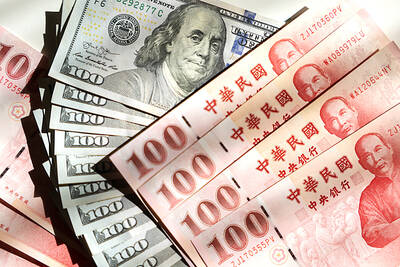Vietnam’s trade deal with the US averts the most punishing of US President Donald Trump’s “reciprocal” tariffs, but analysts warned that it could provoke a fresh standoff between Washington and Beijing.
The Southeast Asian nation has the third-biggest trade surplus with the US of any country after China and Mexico, and was targeted with one of the highest rates in the US president’s “Liberation Day” tariff blitz on April 2.
The deal announced on Wednesday is the first full pact Trump has sealed with an Asian nation and analysts say it might give a glimpse of the template Washington would use with other countries still scrambling for accords.

Photo: AFP
The 46 percent rate due to take effect next week has been averted, with Vietnam set to face a minimum 20 percent tariff in return for opening its market to US products, including vehicles.
However, a 40 percent tariff is to hit goods passing through the country to circumvent steeper trade barriers — a practice called “transshipping.”
Washington has accused Hanoi of relabeling Chinese goods to skirt its tariffs, but raw materials from the world’s No. 2 economy are the lifeblood of Vietnam’s manufacturing industries.
“From a global perspective, perhaps the most interesting point is that this deal again seems in large part to be about China,” Capital Economics said in a note.
The terms on transshipment “will be seen as a provocation in Beijing, particularly if similar conditions are included in any other deals agreed over coming days,” it said.
Chinese Ministry of Foreign Affairs spokeswoman Mao Ning (毛寧) yesterday said that “negotiations and agreements should not target or harm the interests of third parties.”
A Vietnamese Ministry of Foreign Affairs spokesman told reporters that negotiators were still “in detailed discussion to concretize agreements.”
However, there are scant details about the transshipment arrangements in the deal, which Trump announced on Truth Social.
Bloomberg Economics forecast that Vietnam could lose one-quarter of its exports to the US in the medium term, endangering more than 2 percent of its GDP as a result of the agreement.
“The Vietnamese government will now find itself under pressure to ensure that country-of-origin rules are enforced,” said Jack Sheehan, head of regional tax at Asian legal and tax company DFDL.
Uncertainty over how transshipping would be “defined or enforced” is likely to have diplomatic repercussions, Bloomberg Economics expert Rana Sajedi said.
“The looming question now is how China will respond,” Sajedi said. “Beijing has made clear that it would respond to deals that came at the expense of Chinese interests.”
“The decision to agree to a higher tariff on goods deemed to be ‘transshipped’ through Vietnam may fall in that category,” she said.
“Any retaliatory steps could have an outsized impact on Vietnam’s economy,” she added.

MARKET LEADERSHIP: Investors are flocking to Nvidia, drawn by the company’s long-term fundamntals, dominant position in the AI sector, and pricing and margin power Two years after Nvidia Corp made history by becoming the first chipmaker to achieve a US$1 trillion market capitalization, an even more remarkable milestone is within its grasp: becoming the first company to reach US$4 trillion. After the emergence of China’s DeepSeek (深度求索) sent the stock plunging earlier this year and stoked concerns that outlays on artificial intelligence (AI) infrastructure were set to slow, Nvidia shares have rallied back to a record. The company’s biggest customers remain full steam ahead on spending, much of which is flowing to its computing systems. Microsoft Corp, Meta Platforms Inc, Amazon.com Inc and Alphabet Inc are

Luxury fashion powerhouse Prada SpA has acknowledged the ancient Indian roots of its new sandal design after the debut of the open-toe footwear sparked a furor among Indian artisans and politicians thousands of miles from the catwalk in Italy. Images from Prada’s fashion show in Milan last weekend showed models wearing leather sandals with a braided design that resembled handmade Kolhapuri slippers with designs dating back to the 12th century. A wave of criticism in the media and from lawmakers followed over the Italian brand’s lack of public acknowledgement of the Indian sandal design, which is named after a city in the

The US overtaking China as Taiwan’s top export destination could boost industrial development and wage growth, given the US is a high-income economy, an economist said yesterday. However, Taiwan still needs to diversify its export markets due to the unpredictability of US President Donald Trump’s administration, said Chiou Jiunn-rong (邱俊榮), an economics professor at National Central University. Taiwan’s exports soared to a record US$51.74 billion last month, driven by strong demand for artificial intelligence (AI) products and continued orders, with information and communication technology (ICT) and audio/video products leading all sectors. The US reclaimed its position as Taiwan’s top export market, accounting for

INVESTOR RESILIENCE? An analyst said that despite near-term pressures, foreign investors tend to view NT dollar strength as a positive signal for valuation multiples Morgan Stanley has flagged a potential 10 percent revenue decline for Taiwan’s tech hardware sector this year, as a sharp appreciation of the New Taiwan dollar begins to dent the earnings power of major exporters. In what appears to be the first such warning from a major foreign brokerage, the US investment bank said the currency’s strength — fueled by foreign capital inflows and expectations of US interest rate cuts — is compressing profit margins for manufacturers with heavy exposure to US dollar-denominated revenues. The local currency has surged about 10 percent against the greenback over the past quarter and yesterday breached